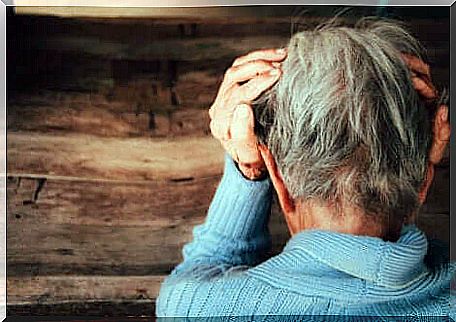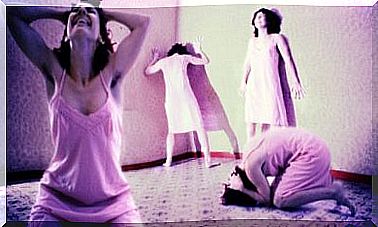Acute Confusion: Symptoms, Types And Treatment

Do you know a syndrome known as acute confusion or delirium? It is a neurocognitive disorder that affects about one to two percent of the general population and about 14 percent of adults over the age of 85.
The main characteristic of this disorder is a change in consciousness that is accompanied by a decrease in the capacity to pay attention and other cognitive changes that affect memory, language, and cognition. As the name suggests, it is an acute condition that usually lasts for hours or days and then goes away completely.
As you will learn in today’s article, the possible causes of acute confusion are many, but mostly of organic origin. These include certain medications, illnesses, poisoning or abstinence from certain substances.
Acute confusion, or delirium, is pathogenic, meaning that symptoms are consistent regardless of the cause. Do you want to know more about this condition? Then you should definitely read on!

Acute Confusion or Delirium: The Beginnings
The condition now known as acute confusion or delirium has been known since ancient times. Hippocrates described it, and Celsus was the first to use the term “delirium,” as evidenced by documents dating from the 1st century BC.
In 1813, Thomas Sutton described a more specific clinical syndrome, delirium tremens, caused by alcohol consumption. Emil Kraepelin later found that each somatic disorder has specific related psychological syndromes.
In 1910 Bonhoeffer described five syndrome groups or clinical variations that were acute over the course of various diseases. These groups were delirium (Latin for delirium), amentia, a twilight state (or epileptic type), arousal, and acute hallucinosis.
What is acute confusion or delirium?
According to DSM-5 (2013), one to two percent of the general population are affected by delirium. The prevalence increases with age and is 14 percent for those over 85 years of age. In addition, 10 to 30 percent of hospital patients also suffer from it. Research shows that men in the older adult population have a higher risk of developing the disease than women.
The DSM-5 (Diagnostic and Statistical Manual of Mental Disorders) classifies acute confusion as a neurocognitive disorder. As we mentioned above, delirium has many potential triggers, which is why the DSM-5 lists five different types:
- Delirium in substance intoxication
- Substance withdrawal delirium
- Drug-Induced Delirium
- Delirium due to other medical conditions
- Delirium due to multiple etiologies
In addition, the DSM-5 also contains certain specifications for the delirium. In terms of duration, the delirium can be acute (hours or days) or persistent (weeks or months). In terms of activity level, delirium can be hyperactive, hypoactive, or mixed. These specifications are of course also taken into account when making a diagnosis.
Acute confusion or delirium – the different types
The DSM-5 divides delirium into subtypes, which are defined by their etiology:
- Delirium in substance intoxication. Various substances can cause delirium. These include alcohol, hallucinogens, amphetamines and related substances, cannabis, cocaine, phencyclidine and related substances, inhalants, opioids, sedatives, hypnotics and anxiolytics.
- Substance withdrawal delirium. In this case, the cause is abstinence, not poisoning from certain substances. These include alcohol (alcohol withdrawal causes delirium tremens), sedatives, hypnotics, and anxiolytics.
- Drug-Induced Delirium. Most medications can induce acute confusion. These include anesthetics, analgesics, antiasthmatics, anticonvulsants, antihistamines, cardiovascular and hypertension drugs, antimicrobials, Parkinson’s drugs, corticosteroids, gastrointestinal drugs, muscle relaxants, and psychotropic drugs with anticholinergic side effects. In addition, toxins can also cause delirium. These include volatile substances (such as gasoline or paint), insecticides, and carbon dioxide.
- Delirium due to other medical conditions. The reality is that virtually any internal medical illness can cause delirium.
- Delirium due to multiple etiologies. If the state of acute confusion can be explained by more than one cause, it is called delirium due to multiple etiologies.
The ICD-10 definition
The WHO also provides a definition of delirium. It can be found in ICD-10 (International Classification of Diseases, in German: International Statistical Classification of Diseases and Related Health Problems). This includes the following features:
- A decrease in awareness and awareness
- General cognitive disorder
- Psychomotor disorders (hypo- or hyperactivity, unexpected change from one state to another)
- Sleep disorders (insomnia and daytime sleepiness)
- Emotional disorders
general characteristics
The general characteristics of acute confusion are as follows:
- Pathogenic Identity. As we mentioned earlier, this means that all patients with delirium will have similar clinical manifestations regardless of the cause of their condition.
- Sudden appearance. The delirium can develop over the course of a few hours or days.
- More or less intense effects on the general condition of the patient. It is a widespread disorder.
- Relatively short duration (this is why delirium is called an “acute” disorder).
- Complete healing is possible.
- In addition, there may be fluctuations in symptoms over the course of the day.

Treatment of acute confusion or delirium
Treatment for acute confusion is aimed at correcting the problem that caused the condition in the first place. Therefore, the intervention approach is to quickly revise the disorder. This can ensure that the condition does not become more severe.
However, a number of interventions can prevent the potential complications of delirium. Also, health professionals can take some general measures to reduce the risks for people with an increased predisposition, such as avoiding sudden environmental changes in the elderly and preventing complications (accidents, infections, etc.).









